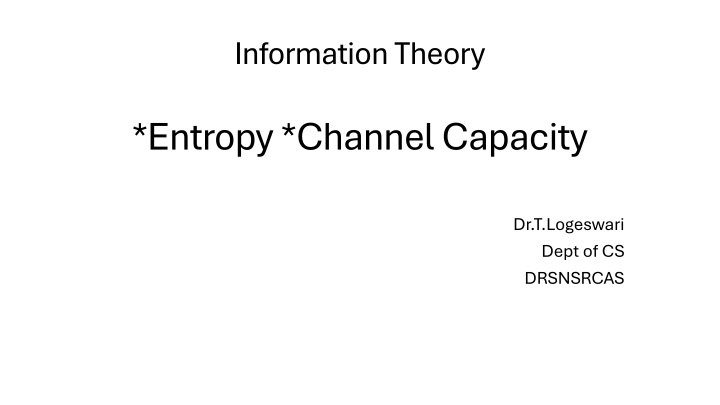
Understand Information Theory and Its Applications
Information theory, pioneered by Claude Shannon, quantifies information in signals and channel capacity for communication systems. Explore concepts like entropy, channel capacity, and noise in this comprehensive overview. Learn how information theory is utilized in engineering and neuroscience for efficient data transmission and representation.
Download Presentation

Please find below an Image/Link to download the presentation.
The content on the website is provided AS IS for your information and personal use only. It may not be sold, licensed, or shared on other websites without obtaining consent from the author. If you encounter any issues during the download, it is possible that the publisher has removed the file from their server.
You are allowed to download the files provided on this website for personal or commercial use, subject to the condition that they are used lawfully. All files are the property of their respective owners.
The content on the website is provided AS IS for your information and personal use only. It may not be sold, licensed, or shared on other websites without obtaining consent from the author.
E N D
Presentation Transcript
Information Theory *Entropy *Channel Capacity Dr.T.Logeswari Dept of CS DRSNSRCAS
What is information theory? Information theory was invented by Claude Shannon in the late 1940 s. The goal of information theory goal of information theory is to quantify the amount of information contained in a signal, as well as the capacity of a channel or communication medium for sending information channel or communication medium for sending information. Information theory is used by engineers to design and analyze the communication systems telephone networks, modems, radio communication, etc. In neuroscience, information theory is used to quantify the amount of information conveyed by a neuron, or a population of neurons, as well as the efficiency of neural representation. capacity of a
In information theory, entropy and channel capacity are concepts that relate to the transmission of information over a channel Key concepts in information theory include: Entropy A measure of the uncertainty associated with a single bit. Entropy is maximized for a uniform distribution The amount of potential information contained is a signal potential information contained is a signal is termed the entropy, usually denoted by H, which is defined as follows: H(X) = P(X) log P(X) x
The channel capacity The amount of information that can be processed per unit time over a noisy channel. In a channel, uncertainty is detrimental to information transfer, so the capacity is equal to 1 - H, where H is the entropy associated with a single bit Channel Channel capacity, capacity, C, C, measures measures the information information that that can can be be sent sent over over a a channel defined as follows: C = max I(X, Y ) P(X) where X is the input to the channel and Y is the output the maximum maximum amount channel (e.g., a wire). It is amount of of
Information Information: Information is a reduction in uncertainty. If an event is certain, it provides no information. However, if the event is uncertain or surprising, it provides information. The amount of information can be measured in bits. Bit Bit: The basic unit of information is the bit (binary digit), representing a choice between two alternatives, such as 0 or 1 in digital systems. Coding Theory Coding Theory: This is a part of information theory that deals with the efficient representation of information. It includes techniques for error detection and correction, as well as data compression Noise Noise: In communication systems, noise refers to any unwanted or random interference that can corrupt the transmitted signal. Information theory helps in understanding how to design systems to minimize the impact of noise. Source Coding (Compression): Source Coding (Compression): Information theory is used to develop algorithms and techniques for compressing data without loss of information. This is essential for efficient storage and transmission of information.
important concepts in information theory are Entropy Channel capacity Binary Symmetric Channel AWGN Channel
Entropy Entropy, in the context of information theory, is a measure of the uncertainty or randomness associated with a random variable. It quantifies the average amount of information contained in a message or the average uncertainty in predicting the value of a random variable. Entropy is a fundamental concept used in information theory for various purposes, including data compression, coding theory, and understanding the limits of communication system Channel Capacity Channel capacity refers to the maximum rate at which information can be reliably transmitted over a communication channel, taking into account the channel's characteristics and potential sources of noise or interference.
It is a fundamental concept in information theory, a branch of applied mathematics and electrical engineering. Claude Shannon, often regarded as the father of information theory, introduced the concept of channel capacity in his landmark paper "A Mathematical Theory of Communication" in 1948. The formula for the channel capacity, known as the Shannon-Hartley theorem, is given by:
The formula indicates that the channel capacity is proportional to the bandwidth and the logarithm of the signal-to-noise ratio. This logarithmic term implies that the channel capacity grows with the signal-to-noise ratio but at a diminishing rate. The concept of channel capacity is crucial in designing communication systems to ensure efficient and reliable information transmission
